Riding your bike can be one of the most liberating feelings in the world. The time alone on the road, the power of human propulsion, and the freedom of no set schedule all add up to an unparalleled feeling of self-reliance and self-discovery. Unfortunately, riding your bike can also leave you at your most vulnerable.
As important as it is to cherish all of the amazing times on your bike, it’s equally important to remember that the road can be dangerous; everything from minor spills to major accidents can have serious consequences not only for your bike, but for your health as well.
Thankfully, some small steps and important precautions can go a long way to keep you upright, riding, and doing what you love… touring!
Top 3 Safety Tips For Bicycle Touring
1. Bicycles Are Traffic!
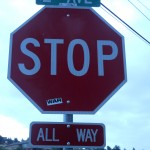 If you’re an experienced rider, this is a no brainer, but if you’re a novice, I’ll repeat it just to make sure you get the point: bicycles are traffic! This means you’re expected to obey all of the same laws as cars on the road.
If you’re an experienced rider, this is a no brainer, but if you’re a novice, I’ll repeat it just to make sure you get the point: bicycles are traffic! This means you’re expected to obey all of the same laws as cars on the road.
When you arrive at stop lights and stop signs, you have to stop (there is an exception: if you’re in Baker, MT or some equally out there destination, I’ll let you get by with a slow and roll).
When you’re turning in traffic, you have to use hand signals. If you’ve forgotten them from childhood, let me remind you: to turn left, hold your left arm out straight, essentially pointing in the direction you want to go; to turn right, bend your left arm at the elbow and hold it straight up in the air.
The bad news is that you’re not going to look like Greg Lemond, but the good news is that you’re less likely to get hit by a car!
It’s also helpful to remember the chant you hear every Super Bowl Sunday: D-Fense! As much as you might love Kevin Bacon’s performance in Quicksilver, always remember that you are not a big city bike messenger. Take your time, anticipate the traffic around you, and always ride defensively. You may be a little slower getting to where you’re going, but you’ll be getting there safely.
Now I know what you’re thinking to yourself: “I’ll ride like traffic when they treat me like traffic.” And that’s a valid point. Unfortunately, using your 25 pound touring rig to play chicken with a Ford F250 is not a very productive use of your time. The truth about getting hit is that to a car, you’re just a bump on the road, but for you, it could be your life.
2. Get Arrested by the Fashion Police (or at Least Get a Citation)
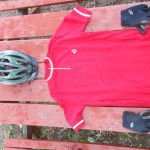 I have been seeing more cyclists with helmets, but I’ll keep saying this, “Every cyclist needs to wear a helmet.”
I have been seeing more cyclists with helmets, but I’ll keep saying this, “Every cyclist needs to wear a helmet.”
I know it’s not the coolest look, and helmet hair can be wicked, but the good thing about helmets is they keep you alive so you can still worry about looking cool.
They’re cheap, they’re proven to work, and they’re the single most important piece of safety equipment you can buy.
I wear a Lazer brand because it switches easily between mountain biking and touring, but any brand will work. They all have to meet the same guidelines and they’ll all keep you safe.
Gloves may seem minor, but they can go a long way, especially for a bicycle tourist. They keep you comfortable while you’re leaning on your bars all day, and if you take a spill, they’ll protect your hands. When you fall from any height, it’s instinctual to put your palms out to break your fall. I prefer for the leather palms to greet the asphalt rather than my bare skin.
Dress bright enough to be seen.
This doesn’t mean you need bright pink cycling shorts (although I do wear hunter’s orange if I’m riding late enough), but it does mean that you should probably skip the black shirt for a long tour or those dusk & dawn commutes.
Bright Lights, Big See Me
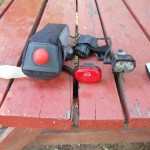 If you’re on an extended tour, or if you’re a crepuscular rider like so many of us commuters are, having a good light set up is essential. There are a lot of different brands and strengths to choose from, but there a couple things you have to keep in mind.
If you’re on an extended tour, or if you’re a crepuscular rider like so many of us commuters are, having a good light set up is essential. There are a lot of different brands and strengths to choose from, but there a couple things you have to keep in mind.
Make sure you’re flashing red from behind. I like to clip a Planet Bike blinky to the back of my helmet and then use my Nite Ize saddle bag. They blink out of syncopation, but that’s what you want; anything to grab the attention of the driver approaching you from behind, and keep it until they pass.
Use a bright front light. If you’re in the city or a heavy congestion area, make sure you have one with a flashing function, but if you’re on an extended tour, just make sure it’s bright. I like to use the CygoLite Mitycross 800: it fastens easily to the bike or your helmet, has a separate, rechargeable battery pack, and is bright as all get out. But no matter what you use, make sure it’s bright and easy to see.
Consider a side light. I have a Nite Ize SpokLite which is light, bright, and lets you be seen from the side. Granted, most traffic isn’t coming from the side, but it still doesn’t hurt to let them know you’re there.
3. Be Careful
I’m a very cautious rider and I’ve been hit. I had a cyclist who was obeying every traffic law, wearing a bright jersey and a helmet, get struck and killed right outside of my house. As prepared as you can be, riding is still inherently dangerous and you have to be careful… that’s probably the soundest advice I can give you.
But with how doom and gloom this post might sound, always remember how completely awesome cycling is. Weigh the risks, assess the situation, and get on your bike; it’s totally worth it.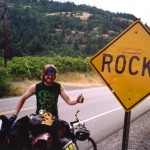
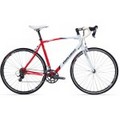
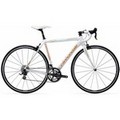
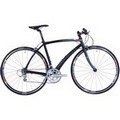

[…] For more tips on staying safe on your next ride or tour, check out these cycling safety tips. […]